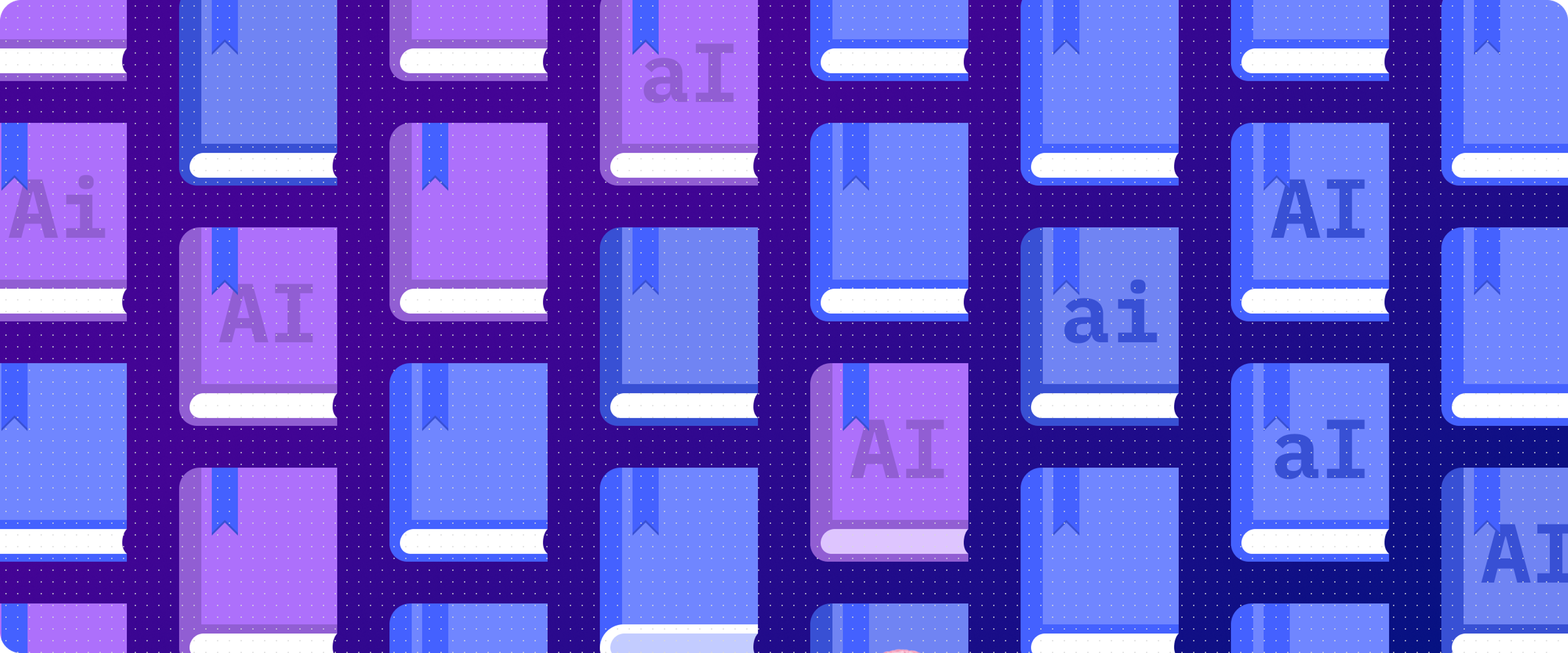
Artificial Intelligence brings exciting new developments to our everyday lives. It also brings a lexicon of new terms into our everyday language. We have put together this glossary to cover both foundational and advanced terms you'll encounter—whether you're dipping your toe into AI, starting to integrate AI technology across your business, or just want to be prepared for when the topic of AI comes up at your next dinner party. Oh, and for some of the more complex terms, we've added further resources.
Here's the full list, in alphabetical order.
AI terms (A-G)
Agent
An AI application designed to achieve high-level goals autonomously, distinguishing it from more interactive AI applications.
AI Ethics
The branch of ethics concerned with how AI systems are designed, implemented, and impact society, focusing on ensuring AI technologies are developed and used in a responsible and equitable manner.
Algorithm
A set of rules or instructions followed by AI to perform tasks or solve problems, forming the backbone of machine learning models.
Application Programming Interface (API)
A set of rules and protocols for building and interacting with software applications, allowing different software systems to communicate and share data and functionalities seamlessly.
Artificial Intelligence (AI)
The broad discipline of creating machines capable of performing tasks that typically require human intelligence, including reasoning, learning, and understanding language.
Autonomous
Describes machines or systems capable of operating independently without human intervention.
Backward Chaining
A reasoning method that starts with the conclusion and works backward to deduce the facts or actions required to reach that conclusion, used in expert systems.
Bias
Prejudices or assumptions in AI decision-making processes, arising from unrepresentative or skewed training data.
Big Data
Extremely large data sets that may be analyzed computationally to reveal patterns, trends, and associations, especially relating to human behavior and interactions.
Bounding Box
In computer vision, a rectangular border drawn around the subject of an image to identify and label it for machine learning models.
Chatbot
A program designed to simulate conversation with human users, especially over the internet, using AI.
ChatGPT
A generative AI model developed by OpenAI, capable of understanding and generating human-like text based on prompts.
Cognitive Computing
A term often used interchangeably with AI, emphasizing the simulation of human thought processes in a computerized model.
Computational Learning Theory
A field of AI that studies the design and analysis of machine learning algorithms.
Computer Vision
A field of artificial intelligence that trains computers to interpret and understand the visual world, enabling machines to identify, classify, and react to objects within images and videos similarly to how humans do.
Corpus
A large collection of texts used for training NLP models, essential for understanding language patterns and structures.
Custom GPT
A version of a generative AI model tailored for specific applications, enabling personalized AI solutions.
Data Mining
The practice of examining large databases to generate new information and find hidden patterns.
Data Science
An interdisciplinary field that uses scientific methods, processes, algorithms, and systems to extract knowledge and insights from structured and unstructured data.
Dataset
A collection of data, often structured with labels, used for training or testing AI models.
Deep Learning
A subset of machine learning in AI that structures algorithms in layers to create an "artificial neural network" that can learn and make intelligent decisions on its own.
Emergent Behavior
Unplanned or unexpected behaviors or capabilities that emerge from the complex interactions within AI systems, often surpassing the originally programmed or intended functionalities.
Entity Annotation
Labeling parts of text with categories or types, such as names of people or locations, to help AI understand and process natural language.
Entity Extraction
The process of automatically extracting structured information from unstructured and/or semi-structured machine-readable documents.
Forward Chaining
A method in which AI starts with available data and uses it to reason outwards to derive new facts, opposite of backward chaining.
Foundation Model
A broad, adaptable AI model pre-trained on vast amounts of data, capable of being fine-tuned for various specific tasks.
Generative AI
AI that generates new content, such as text, images, and videos, through learning from a dataset.
Guardrails
Predefined rules or limitations implemented in AI systems to ensure their operations remain within ethical, legal, and safety boundaries, preventing misuse or harmful outcomes.
AI terms (H-Z)
Hallucination
When AI generates false or irrelevant information, indicating a gap in understanding or processing.
Hyperparameter
Configurations external to the model that influence how the network is trained, such as learning rate or batch size.
Image Recognition
The ability of AI to identify objects, places, people, writing, and actions in images, often used in various applications from security surveillance to social media.
Intent
In NLP, intent refers to the purpose or goal behind a user's input, helping AI to respond appropriately.
Label
In machine learning, a label is the answer or outcome that the model is trained to predict.
Limited Memory
AI systems that can use past experiences or data to make decisions or improve performance for a short period before the data is discarded, unlike long-term memory systems that retain information indefinitely.
Linguistic Annotation
The process of adding information to text about its linguistic structure, such as part-of-speech tags or syntactic trees.
Large Language Model (LLM)
A type of deep learning model that processes and generates human-like text, trained on vast amounts of textual data.
Machine Intelligence
A term encompassing various aspects of AI, including machine learning and deep learning, focused on developing algorithms that enable machines to perform cognitive functions.
Machine Learning (ML)
A subset of AI that allows systems to learn and improve from experience without being explicitly programmed.
Machine Translation
The use of software to translate text or speech from one language to another, without human intervention.
Model
In AI, a model is the output of the training process and is defined by the algorithm and the specific set of weights and biases that have been learned.
Multi-modal
AI systems that can process and integrate information from various types of data, such as text, sound, and images.
Natural Language Processing (NLP)
The ability of computers to understand, interpret, and generate human language.
Natural Language Generation (NLG)
The process of generating natural language text or speech from a machine's internal representation of information.
Natural Language Understanding (NLU)
A subfield of NLP focused on enabling machines to understand the intent and meaning of human language.
Neural Network
A series of algorithms that endeavors to recognize underlying relationships in a set of data through a process that mimics the way the human brain operates.
Overfitting
A modelling error in machine learning is where a model is too closely fitted to the training data, making it perform poorly on new data.
Parameter
Internal configurations of a model that are learned from the training data, influencing the model's predictions.
Pattern Recognition
The automated recognition of patterns and regularities in data, closely related to artificial intelligence and machine learning.
Predictive Analytics
The use of data, statistical algorithms, and machine learning techniques to identify the likelihood of future outcomes based on historical data.
Prescriptive Analytics
Advanced analytics that uses data, mathematical models, and machine learning to suggest actions and strategies for optimal outcomes, going beyond predicting future events to recommending solutions.
Prompt
The text input given to an AI model like ChatGPT, designed to elicit a specific response or output.
Python
A high-level programming language widely used for developing machine learning and deep learning applications.
Quantum Computing
A type of computing that uses quantum bits (qubits) and quantum mechanics principles to perform complex calculations at speeds unattainable by traditional computers, potentially revolutionizing AI processing and capabilities.
Reinforcement Learning
A type of machine learning technique that enables an algorithm to learn through trial and error, using feedback from its own actions and experiences.
Semantic Annotation
The process of linking textual elements to concepts in a knowledge base, enhancing the understanding of text by AI.
Sentiment Analysis
The use of NLP, text analysis, and computational linguistics to identify and extract subjective information from source materials.
Singularity
In the context of artificial intelligence, singularity refers to a hypothetical future point at which AI systems become capable of improving themselves through recursive self-improvement, leading to rapid, exponential growth in intelligence. At this point, AI is theorized to surpass human cognitive abilities, potentially resulting in unforeseeable changes to human civilization. The concept raises significant ethical, philosophical, and safety considerations about the control, impact, and nature of advanced AI entities.
Strong AI
Also known as General AI, the concept of a machine with the ability to apply intelligence to any problem, rather than just one specific problem, akin to the versatile nature of human intelligence.
Structured Data
Data that is organized in a defined manner, often in rows and columns, making it easily searchable and understandable by computer systems, typically used in relational databases.
Supervised Learning
A machine learning technique where models are trained on labeled data, learning to predict outcomes based on input data.
Test Data
Data used to evaluate the performance of a model after it has been trained, separate from the training data.
Token
In natural language processing (NLP), a token is the smallest unit of text that carries meaning, such as a word, part of a word, or a symbol, used by language models to understand and generate text.
Training Data
The dataset used to train an AI model, containing input examples and the corresponding correct outputs.
Transfer Learning
A research problem in machine learning that focuses on storing knowledge gained while solving one problem and applying it to a different but related problem.
Turing Test
A test of a machine's ability to exhibit intelligent behavior equivalent to, or indistinguishable from, that of a human
Unsupervised Learning
A type of machine learning that looks for previously undetected patterns in a dataset with no pre-existing labels and with a minimum of human supervision.
Unstructured Data
Data that lacks a predefined format or organization, making it difficult to collect, process, and analyze using conventional methods. Examples include text, images, and videos.
Validation Data
A subset of data reserved from the training dataset to tune the parameters of a model, providing a testbed for fine-tuning model settings and for preventing overfitting.
Variance
A measure of how much the outputs of a model vary for a given input, high variance can lead to overfitting on the training data.
Variation
In NLP, variations refer to the different ways a user might express a single intent or action, helping models to understand and respond to a range of inputs.
Voice Recognition
The technology enabling computers to recognize and understand spoken language, converting audio into text and allowing for voice-based interactions between humans and machines, such as virtual assistants and voice-controlled devices.
Weak AI
Also known as Narrow AI, refers to AI systems that are designed and trained for a particular task. Unlike General AI, these systems do not possess consciousness, sentience, or mind.
Put your AI terms to work
If you're curious about the real-world impact of AI and looking for a way to streamline your workflows, why not give Relay a go? It's designed to simplify and enhance your processes, blending AI assistance with the invaluable element of human oversight. Check it out for free today.
